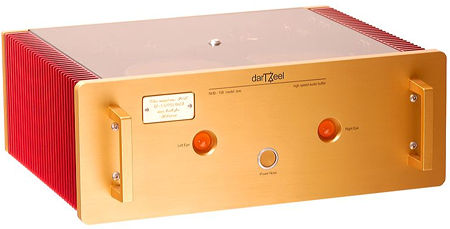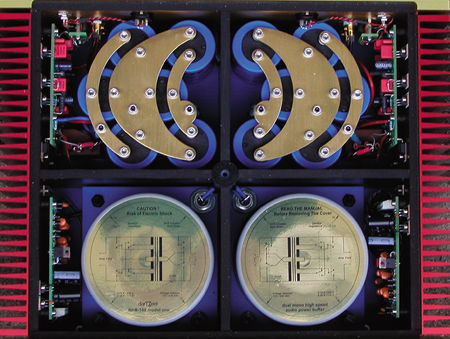| Columns Retired Columns & Blogs |
darTZeel NHB-108 Model One power amplifier
It was late May 2002 and I was about to leave the Free Republic of Bay Ridge, Brooklyn, for the high-class hallways of the New York Hilton and Home Entertainment 2002, so I could file daily reports for www.stereophile.com. As he was giving me last-minute instructions, webmaster Jon Iverson said, "I don't know whether or not you followed Hervé Delétraz's articles on building his amplifier, but he's going to have a sample at the Show. You should drop in and check it out. It sounds kind of interesting."

I had seen Delétraz's amp stories, but I'd only skimmed them, so I dropped by the darTZeel room expecting a kludgy DIY project. There wasn't anything remotely like that on display, so I almost moved on, convinced that Delétraz must have been unable to negotiate the shipping hurdles to bring his engineering-school project from Geneva, Switzerland, to New York.
Fortunately, Delétraz spotted my nametag and introduced himself—we'd corresponded by e-mail a time or two but had never met.
"Too bad you couldn't bring your amp to the show," I commiserated.
"But you're listening to it!"
I goggled at the beautiful, beefy power amp sitting on the floor between the speakers. It featured a thick, gold-anodized faceplate and soft, red-anodized casework and heatsinks. A smoked-glass top plate revealed a topology that looked more sculpted than laid out. A pair of domed indicator lights pulsed softly to the music, and a centrally located power switch lent the front panel an overwhelming resemblance—inadvertent, I assumed—to a face.
It was purty—in fact, the amp's fit'n'finish rivaled that of any audio component I had ever seen. This was a DIY project?
Well, Hervé Delétraz is Swiss. And an engineer. And, well, Swiss.
I sat down and listened. And marveled. And lusted.
"You have got to manufacture this amplifier!" I blurted.
"I would like to," said Hervé, "but it will be quite expensive. I used to think that stereo cost so much that I would be better off making it myself. But when you make only one, it really gets expensive—and I don't think it gets much better if you make 50, either."
"Then you're going to need to make a whole lot of these, because people have got to hear what this amp can do."
"I'd like that," Hervé said.
Delétraz has managed to keep the price more or less stable—in Swiss francs. US dollars is another story. The greenback's precipitous dive has driven the amplifier's Stateside price steadily up. It currently hovers just below $18,200.
Attention must be paid
The darTZeel NHB-108 Model One amplifier (NHB stands for "Never Heard Before") is based, Delétraz says, on the triple principles of simplicity, purity, and reliability. That means the 108 employs open-loop input and output stages with no global negative feedback. Nor does it use relay switches or fuses in the signal path. It employs a scant six transistors per polarity side from input to output, and only a single pair of bipolar output transistors per channel. The NHB-108's output is biased to produce about 20W in class-A, and it runs rather warm—as in Careful around that heatsink, buddy!
Achieving simplicity takes a lot of hard work, however, and the NHB-108 is definitely a piece of work. The CNC-routed aluminum casework includes inner and outer compartments: the inner compartment, beneath the case's "outer interior," contains much of the wiring; the outer compartment contains the massive power supply and the output devices, which are attached to the heatsinks. The storage capacitors are huge honkin' things, and the recursive, gold-plated buses that connect them to the circuit look like Victorian drafting tools—or maybe I mean Edwardian. You know, they scream elegance.

Nothing went into the NHB-108 casually. The case components are damped and decoupled from one another by absorptive bumpers, and the placements of all active devices were the subjects of constant experimentation by Delétraz. All of the 108's components are of extremely high quality. The binding posts are WBT, for example, but many others, such as the BNCs and those golden bus bars, look bespoke.
Did I mention that the darTZeel is handmade? It is—and looks it. Not as if I handmade it, which would have made it lopsided and only sporadically operational. It looks handmade like a . . . like a . . . well, like a Swiss watch. There. I said it.
If you want to explore the technical minutiae of the darTZeel, its setup manual and an "audiophile's technical manual" can be downloaded from the Web. These are fun to read, in no small part because of Delétraz's ruminations on the natures of music and timing. If that's more than you want to know about the subject, however, there are a few practical considerations that you should know about the NHB-108.
First, because of Delétraz's somewhat controversial views on impedance matching for connections, the darTZeel has an input impedance of 100k ohms for its RCA inputs and includes a pair of 50 ohm (!) BNC connectors for the impedance-matched "Zeel" input, just in case you have a preamp handy that employs this connection scheme and impedance (footnote 1). (If you don't, Delétraz introduced the darTZeel NHB-18NS preamplifier—which does—at the 2005 Consumer Electronics Show.)
Current NHB-108s also have balanced XLR inputs, though the sample I auditioned was not balanced. According to Delétraz, my sample was optimized for use with the BNC connection. When I used the RCA inputs, I needed to connect the grounds of the speaker outputs together to cancel a hum that was otherwise present—current production of the amp doesn't need this strap, he tells me. (John Marks, who reviewed the NHB-108 in his September 2003 "The Fifth Element" column, says the quality of the ground wire can make a difference in sound quality, but I never experimented with this; I'm not sure I wish to confront a reality in which this would be true.)
The other practical consideration for most users is that the NHB-108 is particular about loudspeaker impedance; users need to set two internal switches to Lo to optimize the amp's performance with 4 ohm (or lower) speakers. Otherwise, the NHB-108's switches should be set to Hi. I had no problem with it driving any of the speakers I had on hand, but then again, I didn't have anything too exotically demanding around the house.
Footnote 1: Hervé Delétraz wrote about the theoretical benefit of impedance-matched connections in the November 2001 issue of Stereophile (pp.59–69). Note that M. Delétraz was not a manufacturer at that time.—Ed.
- Log in or register to post comments




































